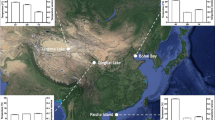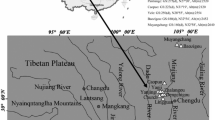Summary
Clutch volume, egg volume and clutch size were studied in four populations of introduced Canada Geese in Sweden along an 850 km latitudinal gradient. These recently established populations were not assumed to be adapted to their breeding habitats. Clutch volume as well as egg volume differed significantly between some of the populations. Clutch volume was significantly higher in a population which had its breeding area within spring feeding areas, compared to a population which migrated 350 km between the last major foraging area and the breeding area. Thus, we found some support for the energy reserve hypothesis, which predicts that the body reserves of the female determine her energy investment in the clutch. Egg size differed on a geographic basis, and one population had significantly smaller eggs than two of the others. Clutch size did not vary significantly between the populations. A significant year effect on clutch volume and clutch size was found.
Zusammenfassung
An vier Populationen in Schweden eingeführter Kanadagänse wurden einem Gradienten geographischer Breite folgend Volumina von Gelege und Eiern sowie Gelegegröße untersucht. Es ist nicht anzunehmen, daß diese erst seit kurzer Zeit ansässig gewordenen Populationen an ihre Bruthabitate angepaßt sind. Sowohl im Gelege- wie im Eivolumen zeigten sich signifikante Unterschiede zwischen einigen Populationen. In einer Population, deren Brutgebiet innerhalb der Weideflächen liegt, die die Vögel im Frühjahr aufsuchen, war das Gelegevolumen signifikant höher als in einer Population, die vom letzten bedeutenden Weidegebiet bis zu ihrem Brutgebiet ca. 350 km gezogen war. Die „Energiereserve-Hypothese”, die besagt, daß die Körperreserven des Weibchens seine Investition an Energie in das Gelege bestimmen, findet somit in unseren Ergebnissen etwas Unterstützung. Die Eigröße variierte von Brutgebiet zu Brutgebiet mit der geographischen Lage; eine Population wies signifikant kleinere Eier auf als zwei der übrigen. Nicht signifikant variierte die Gelegegröße zwischen den Populationen. Gefunden wurde ein signifikanter Effekt der jeweiligen lokalen Bedingungen auf Gelegevolumen und -größe.
Similar content being viewed by others
Literature
Alisauskas, R. T., &C. D. Ankney (1992): The cost of egg-laying and its relation to nutrient reserves in waterfowl. In:Batt, B. D. J. et al., The ecology and management of breeding waterfowl, Chapter 3. Minneapolis. In press.
Ankney, C. D. (1980): Egg weight, survival, and growth of Lesser Snow Goose goslings. J. Wildl. Manage. 44: 174–182.
&C. D. Macinnes (1978): Nutrient reserves and reproductive performance of female Lesser Snow Geese. Auk 95: 459–471.
Åström, M. (1990): Foraging time in herbivores. Ph. D. thesis, Sw. Univ. Agr. Sci., Umeå.
Bellrose, F. (1976): Ducks, geese & swans of North America. Harrisburg.
Bird-Ringing Centre (1986): Reports on Swedish Bird-ringing for 1976. Sw. Mus. Nat. Hist., Stockholm.
Birkhead, M. (1984): Variation in the weight and composition of Mute Swan (Cygnus olor) eggs. Condor 86: 489–490.
(1985): Variation in egg quality and composition in the MallardAnas platyrhynchos. Ibis 127: 467–475.
Boag, P. T., &A. J. van Noordwijk (1987): Quantitative genetics. In:Cooke, F. &P. A. Buckley, Avian Genetics. A population and ecological approach: 45–78. London.
Budaeu, D. A., J. T. Ratti &C. R. Ely (1991): Energy dynamics, foraging ecology, and behaviour of prenesting Greater White-fronted Geese. J. Wildl. Manage. 55: 556–563.
Calverley, B. K., &D. A. Boag (1977): Reproductive potential in parkland- and arctic-nesting populations of Mallards and Pintails (Anatidae). Can. J. Zool. 55: 1242–1251.
Cooper, J. A. (1978): The history and breeding biology of the Canada Geese of Marshy Point, Manitoba. Wildl. Monogr. 61.
Duncan, D. C. (1987): Variation and heritability in egg size of the Northern Pintail. Can. J. Zool. 65: 992–996.
von Essen, L., &E. Fabricius (1969): Kanadagåsen i Sverige. Svensk Jakt 107: 13–16.
Fabricius, E. (1983): The Canada Goose in Sweden. Statens naturvårdsverk PM 1678.
Findlay, C. S., &F. Cooke (1983): Genetic and environmental components of clutch size variance in a wild population of Lesser Snow Geese (Anser caerulescens caerulescens). Evolution 37: 724–734.
Gauthier, G., &J. Tardif (1991): Female feeding and male vigilance during nesting in Greater Snow Geese. Condor 93: 701–711.
Hoyt, D. F. (1979): Practical methods of estimating volume and fresh weight of bird eggs. Auk 96: 73–77.
Kossack, C. W. (1950): Breeding habits of Canada Geese under refuge conditions. Am. Midl. Nat. 43: 627–649.
Lessells, C. M. (1982): Some causes and consequences of family size in the Canada GooseBranta canadensis. Ph. D. thesis, Univ. Oxford.
Macinnes, C. D., & E. H. DUNN (1988): Components of clutch size variation in arctic-nesting Canada Geese. Condor 90: 83–89.
R. A. Davis, R. N. Jones, B. C. Lieff &A. J Pakulak (1974): Reproductive efficiency of McConnell River small Canada Geese. J. Wildl. Manage. 30: 536–553.
Madsen, J. &Å. Andersson (1990): Status and management ofBranta canadensis in Europe. In:Matthews, G. V. T., Managing Waterfowl Populations: 66–69. IWRB Spec. Publ. 12. Slimbridge, UK.
Mainguy, S. K., &V. G. Thomas (1985): Comparisons of body reserve buildup and use in several groups of Canada Geese. Can. J. Zool. 63: 1765–1772.
Manning, T. H. (1978): Measurements and weights of eggs of the Canada Goose,Branta canadensis, analyzed and compared with those of other species. Can. J. Zool. 56: 676–687.
Martin, T. E. (1987): Food as a limit on breeding birds: A life history perspective. Ann. Rev. Ecol. Syst. 18: 453–487.
National Board of Agriculture (1991): Yearbook of farm statistics 1990. Helsinki.
Nudds, T. D. (1978): Comments on Calverley and Boag's (1977) hypothesis on displaced ducks and an evolutionary alternative. Can. J. Zool. 56: 2239–2241.
Prop, J., M. R. van Eerden &R. H. Drent (1984): Reproductive success of the Barnacle GooseBranta leucopsis in relation to food exploitation on the breeding grounds, western Spitsbergen. Nor. Polarinst. Skr. 181: 87–117.
Raveling, D. G. (1979): The annual cycle of body composition of Canada Geese with special reference to control of reproduction. Auk 96: 234–252.
Rohwer, F. C., &D. I. Eisenhauer (1989): Egg mass and clutch size relationships in geese, eiders and swans. Ornis Scand. 20: 43–48.
Ryder, J. P. (1970): A possible factor in the evolution of clutch size in the Ross' Goose. Wilson Bull. 82: 5–13.
Statistics Sweden (1990): Yearbook of Agricultural Statistics 1990. Stockholm.
Swedish Institute of Meteorology and Hydrology (1986–1990): Weather and water. Norrköping, Sweden.
Author information
Authors and Affiliations
Rights and permissions
About this article
Cite this article
Sjöberg, G., Sjöberg, K. Geographical variation in reproductive investment in Canada Geese (Branta canadensis) in Sweden. J Ornithol 133, 403–412 (1992). https://doi.org/10.1007/BF01640468
Published:
Issue Date:
DOI: https://doi.org/10.1007/BF01640468




